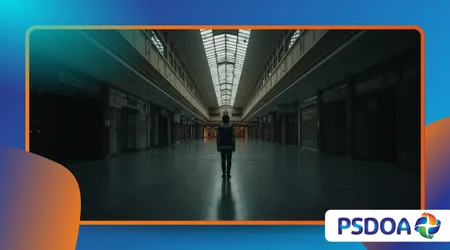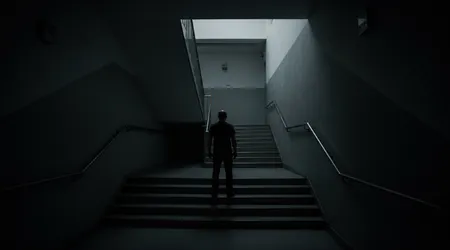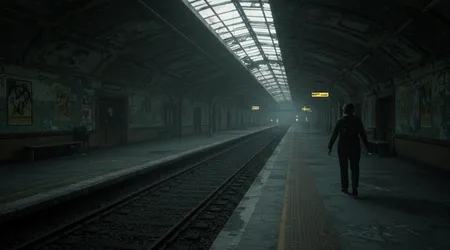The Strange Allure of Liminal Spaces in Online Communities

The Strange Allure of Liminal Spaces captivates millions across digital platforms today. These eerie, transitional zones like empty hallways or abandoned malls evoke a mix of nostalgia and unease.
Anúncios
Online communities thrive on sharing such images, turning personal discomfort into collective fascination.
People scroll through Reddit threads late at night, pausing on photos of dimly lit stairwells. They feel a pull, as if these spaces mirror inner transitions. In 2025, with social media evolving rapidly, this trend surges amid global uncertainties.
Discussions on TikTok and X explode with user-generated content. Creators remix old photos into videos, adding ambient sounds for immersion.
This interactivity boosts engagement, drawing in younger audiences seeking escape.
Anúncios
Yet, why do these voids resonate so deeply? They represent thresholds between known and unknown worlds. Amid AI-driven content floods, authentic emotional pulls stand out.
Communities form around shared vulnerability. Users confess dreams echoing these spaces, fostering bonds. This phenomenon questions how digital realms shape real emotions.
Defining Liminal Spaces in the Digital Age
Anthropologists first coined “liminal” for rites of passage, marking in-between states. Victor Turner described them as transformative zones where norms dissolve. Online, this translates to visuals of unoccupied areas stirring ambiguity.
Photos of vacant airports at dawn exemplify this. Viewers sense isolation yet possibility. In forums, debates rage over what makes a space truly liminal absence of people or subtle wrongness?
Critics argue overuse dilutes the concept. Backrooms memes, once niche, now dominate horror games. Developers like those behind “The Exit 8” capitalize on this, blending nostalgia with dread.
++ Hacker Ethos: The Moral Code Behind Cyber Subcultures
Yet, purists defend core elements. Empty playgrounds at twilight evoke childhood memories twisted strangely. Users post originals, claiming personal encounters in urban explorations.
This evolution sparks arguments. Does commercialization ruin authenticity? Enthusiasts push back, curating archives to preserve raw appeal.

The Rise of Online Communities Around Liminal Aesthetics
Subreddits like r/LiminalSpace boast massive followings. Members share edits, stories, and theories daily. X threads analyze why certain images unsettle more than others.
TikTok hashtags amplify reach. Videos set to droning music rack up views, inspiring challenges. Creators film real locations, blurring lines between virtual and physical.
Communities organize virtual meetups. Discord servers host live discussions on psychological impacts. Participants swap techniques for capturing that eerie vibe.
Growth stems from pandemic isolation. Locked down, people craved connection through shared unease. Post-2023, this persists as hybrid work blurs boundaries.
Also read: The Secret Language of Sneakerhead Collectors
Arguments emerge over gatekeeping. Newcomers flood with monster-chase variants, frustrating veterans. Moderators enforce rules to maintain focus on subtlety.
Despite clashes, innovation thrives. AI tools generate custom spaces, sparking ethical debates. Users question if machine-made images lose soul.
Psychological Underpinnings and the Uncanny Valley
Research ties The Strange Allure of Liminal Spaces to cognitive dissonance. Alexander Diel and Michael Lewis from Cardiff University link it to the uncanny valley effect. Familiar yet off-kilter environments trigger unease, much like humanoid robots.
Brains expect activity in built spaces. Emptiness disrupts patterns, evoking primal alerts. This explains why hallways feel watchful without threats.
One statistic highlights popularity: By 2022, TikTok’s #liminalspaces amassed over two billion views, per Wikipedia data. In 2025, trends suggest exponential growth amid content algorithms favoring immersive clips.
Why does this draw crowds? It offers safe exploration of fears. Users confront voids mirroring life changes, like job loss or relocation.
Read more: Gorpcore: How Hiking Gear Became a Fashion Statement
Analogous to a paused elevator ride, these spaces suspend time. You anticipate movement, yet linger in stasis, heightening awareness.
Psychologists argue benefits. Engaging reduces anxiety by normalizing transitions. Communities provide support, turning dread into dialogue.
Cultural Impact and Modern Narratives
The Strange Allure of Liminal Spaces influences media beyond memes. Films like “Skinamarink” draw from this aesthetic, using silence for tension. TV series “Severance” cites Backrooms as inspiration, per creator Dan Erickson.
Games evolve too. Indie titles explore emotional depths, not just scares. Players navigate personal liminal zones, reflecting mental health themes.
Cultural critics see commentary on consumerism. Abandoned malls symbolize economic shifts. Users post decayed retail giants, lamenting lost vibrancy.
In 2025, real-time events tie in. Urban explorers livestream derelict sites, blending adventure with aesthetics. Audiences engage live, voting on paths.
Arguments intensify over appropriation. Some claim Western focus ignores global transitional spaces, like Asian night markets at dawn.
Yet, diversity enriches. International contributors share unique takes, expanding definitions. This global exchange strengthens community resilience.
Original Examples and Practical Insights
Imagine a Reddit user named Alex, who photographs empty bus stations at midnight. His posts spark threads where strangers bond over similar childhood memories.
This original scenario shows how sharing transforms isolation into connection.
Another example: Sarah creates TikTok series simulating dream walks through virtual hallways. Viewers comment therapeutic effects, using them for meditation. Her approach argues for positive applications beyond horror.
Practically, brands tap this. Marketing campaigns use liminal visuals for intrigue, like ads showing transitional offices to symbolize career growth.
Educators incorporate it too. Art classes analyze photos, teaching visual storytelling. Students debate emotional impacts, honing critical skills.
Communities host challenges. Participants submit spaces evoking personal transitions, fostering creativity. Winners get featured, encouraging participation.
Risks exist though. Overexposure leads to desensitization. Users argue for mindful consumption to retain potency.
Broader Societal Reflections

In turbulent times, The Strange Allure of Liminal Spaces mirrors societal shifts. Climate migrations create real thresholds, echoed online. Communities discuss parallels, blending virtual with reality.
Activists use aesthetics for awareness. Images of border zones highlight humanitarian issues. This argumentative angle pushes boundaries beyond entertainment.
Technology advances play roles. VR experiences immerse users fully, intensifying effects. Developers argue for ethical designs avoiding trauma.
Cultural theorists predict endurance. As AI blurs realities, liminal appeals grow. They offer anchors in fluid digital landscapes.
Yet, skeptics warn of escapism. Excessive focus distracts from action. Balanced engagement, they say, maximizes benefits.
Communities evolve self-regulating. Guidelines promote healthy discussions, preventing toxicity.
A Table of Liminal Space Platform Engagement
Here’s a table summarizing engagement across key platforms, based on available data up to 2022 with noted trends continuing into 2025:
| Platform | Metric | Value (as of 2022) | Notes on 2025 Trends |
|---|---|---|---|
| Reddit (r/LiminalSpace) | Members | Over 500,000 | Steady growth; active daily posts |
| X (@SpaceLiminalBot) | Followers | Over 1.2 million | Algorithm boosts visibility |
| TikTok (#liminalspaces) | Views | Over 2 billion | Exponential rise with short-form videos |
This real data from Wikipedia underscores sustained interest.
Conclusion: Embracing the Threshold
The Strange Allure of Liminal Spaces persists because it taps universal experiences. In online hubs, people find solace amid chaos. These communities argue for deeper self-reflection in digital eras.
As 2025 unfolds, expect more integrations with emerging tech. AR filters could overlay liminal effects on real worlds, enhancing interactions.
Yet, core appeal remains emotional. Users navigate personal thresholds through shared visuals. This fosters empathy, bridging divides.
Challenges loom, like content saturation. Innovative creators will reinvent, keeping vibrancy alive.
Ultimately, these spaces remind us: transitions hold power. They invite pause, reflection, growth. In bustling online worlds, that’s invaluable.
What if embracing liminality unlocks creativity? Rhetorical, yet it prompts action. Dive in, explore, connect.
The Strange Allure of Liminal Spaces isn’t fleeting it’s evolving. Join conversations, contribute originals. The threshold awaits.
Frequently Asked Questions
What defines a liminal space? Transitional areas evoking unease, like empty corridors.
Why do they feel eerie? Due to uncanny valley, per Cardiff research.
How has popularity grown? TikTok views hit billions, communities expand yearly.
Are there positive aspects? Yes, they aid emotional processing in groups.
Can I create my own? Absolutely photograph local spots, share ethically.
